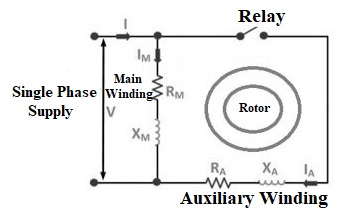What is Split Phase Induction Motor?
An alternate name
of the motor is resistance to start the motor. This motor has a single-phase
along with a stator as well as a rotor with a single cage. The stator of this
type of induction motor includes two windings like main & an auxiliary or
starting winding. The arrangement of these two windings can be done with
90°separately in space. These motors are available in different types like
resistance split-phase, capacitor split-phase, capacitor start, and permanent
capacitor.

The working
principle of a split-phase induction motor is related to a poly phase induction
motor. But the main disparity is, in single phase motor, it does not generate a
rotary magnetic field whereas the polyphase generates simply a pulsating filed.
Therefore, phase splitting can be done to generate the rotary magnetic field
for self-starting and to run the motor like a two-phase induction motor for
starting.
Split Phase Induction Motor Theory
The Split phase
induction motor diagram is shown below. The following diagram can be built with
main winding resistance (Rm), main winding inductive resistance (Xm), series
resistor (Ra), inductive reactance with auxiliary winding (Xa), relay or
centrifugal switch (S). In this motor, the main winding has less resistance
& high inductive reactance whereas the auxiliary winding has less inductive
reactance and high resistance.
In the above
diagram, both the resistor & the auxiliary winding are connected in series.
The flowing current in the windings cannot be equal consequently the rotary
field is not consistent therefore, the initial torque is little. At the
beginning of the motor, the two windings are allied in parallel.
Working of Split Phase Induction Motor
Once the motor gets
the 70 to 80 % of the synchronous speed then the starting winding can be
detached automatically from the mains supply. If this motor is rated with 100
Watt or above then a centrifugal switch is utilized for disconnecting the
starting winding. Similarly, if the motor has less rating then a relay is utilized
to detach the winding by connecting in series with main winding.
Once the current
flow through the circuit, the relay gets closed. So, the starting winding is
within the circuit & when the motor gets the fixed speed, then the flowing
current within the relay will start reducing. Thus, the relay opens & the
auxiliary winding can be detached from the mains supply to make the motor run
on the main winding simply.
The current in the
main winding (IM) can be lagged behind the supply voltage ‘V’ almost by the
90-degrees of angle. The current in the auxiliary winding IA is approximately
in phase with the line voltage. Thus, there exists a time difference between
the currents of the two windings. The time phase difference ϕ is not 90
degrees, but of the order of 30 degrees. This phase difference is enough to
produce a rotating magnetic field.
Phasor Diagram
The split phase
induction motor phasor diagram is shown below. The flow of current within the
IM (main winding) can be lagged after the voltage supply approximately through
the 90 degrees angle. Here, IA is the flow of current within the auxiliary
winding can be around in phase through the line voltage. Therefore, the time
disparity among the two windings current can exist. The phase difference of
time ‘ϕ’ is not 90 degrees, but 30 degrees. So to generate the rotating
magnetic field, this phase difference is sufficient.
Advantages
The advantages of a
split phase induction motor include the following.
- The motor is economical & can be changed once it wears out before trying to reverse it.
- These are available in different frame sizes so that they can be placed effortlessly in most of the machines.
Disadvantages
The disadvantages
of a split phase induction motor include the following.
- These motors have less starting torque, so not suitable for above 1 KW.
- This motor is power output and efficiency. As compared to a 3-phase motor, these are unsuccessful while changing the energy from electrical to working.
- These motors relay simply on the different resistance & inductance of the starting winding.
- These are used where high starting torque is mandatory like an air compressor.
- These are suitable for the loads which start easily such as fans, grinding wheels etc.
Applications
The applications of
split phase induction motor include the following.
- This motor include in different loads which are used for general purpose. Generally, these loads are AC, grinders, lathe machine, drilling, Washing machines, AC fans, drill presses, centrifugal pumps, floor polishers, blowers, mixer grinder, heating blowers with belt-driven and conveyors with tiny belt-driven.
- This motor is used where the distribution of the three phases is not required.
- This moor does not give lots of starting torque, thus the load should be quite small, ad where mechanical gain can be used to assist the motor to begin.







0 Comments